by Anne Chesky
“The Captain Juan Pardo went out from the city of Santa Elena on November 1, 1566, to enter into the interior to discover it and conquer it from here to Mexico,” read an account of the Spanish explorer’s 1566 expedition, which brought him and his men into present-day Western North Carolina.
It was during this expedition that Pardo and his men established the first European settlement in the interior of the United States, 20 years before Sir Walter Raleigh failed to establish an English colony on Roanoke Island.
Image: One of the burned Spanish buildings at the Berry Site near Morganton
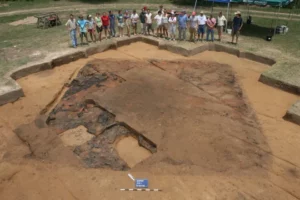
Read at Asheville Citizen-Times
Joara
The Catawba River valley, located at the base of WNC’s mountains, was the most populated area of inland North Carolina for at least a century prior to the arrival of Spanish explorers. Most people inhabiting this land lived in small towns, hamlets, or farmsteads. They grew sunflowers, tobacco, corn, beans, and squash.
Joara, a native town near present-day Morganton, served as the political, economic, and ritual center of the region. Established around 1000 AD, Joara was surrounded by rivers, creeks, and low mountains. It soon became a transportation hub controlled by the leaders of Joara.
De Soto and the Lady of Cofitachequi
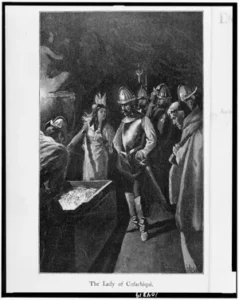 The Lady of Cofitachequi gives De Soto the town’s “Treasure.”
The Lady of Cofitachequi gives De Soto the town’s “Treasure.”
In 1540, Spanish explorer Hernando De Soto, his men, and Africans they held as slaves became the first known non-native people to travel through Joara and into Western North Carolina. According to those chronicling the expedition, De Soto’s group arrived in Joara thanks to a native woman they called the Lady of Cofitachequi.
As De Soto’s army marched north from Florida in an attempt to claim the southeast for Spain, they took a young native boy hostage. He told them of a chiefdom near present-day Camden, South Carolina, known as Cofitachequi, which was ruled by a female chief. She was said to have a large cache of gold. But when the Spaniards arrived in Cofitachequi, they could only find copper, mica, and freshwater pearls. They began looting Coritachequi’s mortuary temples. They still found no gold.
In hopes of finding riches farther north, the men took the chief — known as the Lady of Cofitachequi — hostage to use as a navigator. Though she was supposed to take them to the Coosa province, she led the army toward the mountains to the northwest in an attempt to misdirect them. After setting the course for the Spaniards, she began to plan her escape.
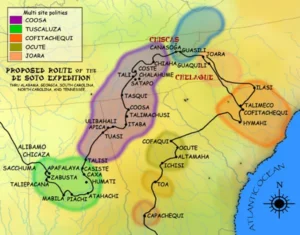
A map showing the de Soto expedition route through the future U.S. states of Georgia, South Carolina, North Carolina, Tennessee, and Alabama. Based on the Charles M. Hudson map of 1997.
According to the “De Soto Chronicles, 1539-1543,” she “stepped aside from the road and went into a wood saying that she had to attend to her necessities. Thus she deceived them and hid herself in the woods; and although they sought her she could not be found. … (She) remained in (Joara) with a slave who refused to come with them; and it was very certain that they held … as husband and wife.”
De Soto’s army stayed in Joara several days before continuing the expedition. They never found the Lady of Cofitachequi.
Juan Pardo and Fort San Juan
More than 25 years later, on Dec. 1, 1566, Spanish Captain Juan Pardo and half of his men embarked on an expedition to once again try to claim the U.S. interior for Spain. At the same time, they hoped to map a route to silver mines in Mexico.
Pardo’s small army followed established trails as they made their way into what is now North Carolina. The group stopped in each native town they encountered to acquire food and supplies – while also letting the town’s residents know that they were now subjects of the king of Spain.
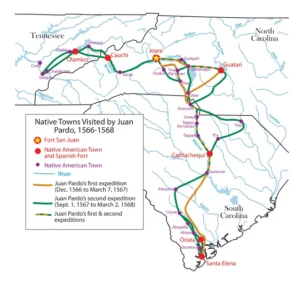
Map of the Native American towns visited by Juan Pardo, 1566-1567.
By the time Pardo arrived in Joara, it was the beginning of January 1567. The mountains of Western North Carolina were covered in snow. Joara Mico, who ruled the town and much of the surrounding area, greeted the party and accepted gifts, including a set of metal knives.
Juan Pardo wrote of this meeting: “The next day I departed and went to (Joara), where I found a large number of Indians and caciques (chiefs). I made the customary speech to them and they all remained under the dominion of His Holiness and His Majesty.”
Pardo, who had deemed it prudent to wait until spring to scale the mountains, asked Joara Mico to allow the Spaniards to build Fort San Juan as well as a small settlement, Cuenca, adjacent to the town. Mico agreed.
After overwintering in Cuenca, Pardo returned to Santa Elena. He left 30 men to defend the fort and occupy the town. Joara Mico then sent the 30 Spanish soldiers to help Joaran warriors conquer a rival chiefdom near present-day Saltville, Virginia.
According to the official scribe for Pardo’s expedition, before leaving, “(Pardo) commanded … that no one should dare bring any woman into the fort at night … under pain of being severely punished.” Despite this, a native woman present in Joara at the time, Teresa Martin, later told officials that after Pardo had been absent from the fort for “three or four moons,” Spanish soldiers began to commit improprieties with native women.
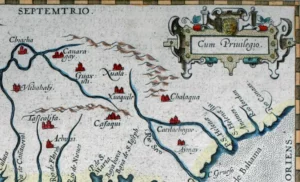
A portion of a 1584 map by Geronimo Chaves depicting the site of Xuala where, in 1567, Juan Pardo established Fort San Juan.
Relationships commonly occurred between native women and Spanish men at this time. And archaeological evidence found inside the fort shows that native women likely cooked for the soldiers and may have even lived inside the fort.
Native men, potentially angered by relationships between native women and Spanish soldiers — as well as the Spanish men’s increasing demand for food — retaliated with force, luring the soldiers from the fort. Native men from across the region then burned Fort San Juan and five other nearby Spanish forts to the ground during the spring of 1568, again thwarting Spanish attempts to settle the Southeast.
Only one soldier survived, Teresa Martin’s husband, Juan Martin de Badajoz. He fled to Santa Elena on the coast to report the fort’s fall.
Teresa and Juan Martin would eventually raise two daughters in Santa Elena. In July 1576, Juan was killed during a military skirmish against native warriors. Teresa was allowed to collect his final pay. The historic record does not reveal much more about Teresa. Scholars believe she was either a native Joaran or a resident of a neighboring chiefdom kidnapped by Pardo’s men.
Rediscovering Joara and Fort San Juan
Though Joara persisted and likely existed well into the 1600s, the town did not reappear in the historic record for more than 300 years. In 1891, the Smithsonian described a site 8 miles north of Morganton with a 15-foot-high unexplored earthen mound. The mound was eventually determined to be part of Joara. Around 1940, before more than a few surface-level explorations had been performed, a farmer plowed down the mound to use the land for agriculture.
Forty years later, after modern archaeological investigations began at the site, Joara was officially rediscovered. When, in the 1990s, Spanish artifacts were excavated at the site, archaeologists began to theorize that they had also rediscovered Fort San Juan and Cuenca. It took 20 more years of excavations to confirm it. In 2013, the burnt remains of Fort San Juan reemerged.
Today, archaeological investigations continue at the sites of Joara, Fort San Juan and Cuenca. To find out more about the site — known as The Berry Site — and current discoveries, visit the Exploring Joara Foundation online at exploringjoara.org.
Anne Chesky is the executive director of the Asheville Museum of History.
